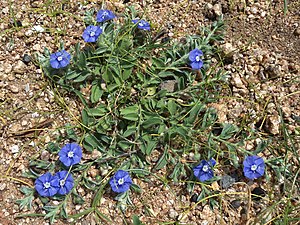Note: This is a project under development. The articles on this wiki are just being initiated and broadly incomplete. You can Help creating new pages.
Evolvulus alsinoides - Vishnukanti
Vishnukranti is a tiny prostrate spreading herb with silky hairy leaves and bright blue flowers. It can be found throughout India in gravelly and grassy places.
Contents
- 1 Uses
- 2 Parts Used
- 3 Chemical Composition
- 4 Common names
- 5 Properties
- 6 Habit
- 7 Identification
- 8 List of Ayurvedic medicine in which the herb is used
- 9 Where to get the saplings
- 10 Mode of Propagation
- 11 How to plant/cultivate
- 12 Commonly seen growing in areas
- 13 Photo Gallery
- 14 References
- 15 External Links
Uses
Insomnia, Bleeding disorders, Improves memory, Cough, Wounds, Fever, Stomach ache, Dysentery[1]
Parts Used
Chemical Composition
Evolvulus alsinoides (Linn.) Linn. was interpreted to find the phytochemicals like alkaloids, carbohydrates, steroidal glucosides, saponin, tannins, pseudo tannins, chlorogenic acids, flavones, flavonoids, coumarin, anthocyanin, phenol, terpenoides, resins, volatile oil, anthraquinones, phytosterol and triterpenoids.[3]
Common names
| Language | Common name |
|---|---|
| Kannada | Vishnukranti, Shankhapushpi |
| Hindi | Sankhpushpi, Shankaveli, Visnukranta |
| Malayalam | Krsnakranti, Vishnukranthi |
| Tamil | Paracitam, Potakiranti, Potakiranticceti, Villakkiranti, Vishnukranti |
| Telugu | Vishnukraantha, Visnukrantamu |
| Marathi | NA |
| Gujarathi | NA |
| Punjabi | NA |
| Kashmiri | NA |
| Sanskrit | Shankhapushpi, Nilapushpi, Sankhaholi, Vishnukranti |
| English | Dwarf morning glory |
Properties
Reference: Dravya - Substance, Rasa - Taste, Guna - Qualities, Veerya - Potency, Vipaka - Post-digesion effect, Karma - Pharmacological activity, Prabhava - Therepeutics.[5]
Rasa
Kashaya, Katu, Tikta
Guna
Lagu, Snigdha
Veerya
Sita
Vipaka
Madhura
Habit
Identification
Leaf
| Kind | Shape | Feature |
|---|---|---|
| Simple | Alternate | Leaves more or less distinctly in 2 rows, 6-12 x 4-7 mm, broadly elliptic to elliptic-lanceolate, base rounded or acute, apex subacute, adpressed pilose on both sides; petiole to 2 mm long. |
Flower
| Type | Size | Color and composition | Stamen | More information |
|---|---|---|---|---|
| Bisexual | Solitary or paired at axils | Blue | 10 | Pedicels to 5 mm long, silky hairy; bracts linear, c. 1 mm long. Calyx lobes 2-3 mm long, lanceolate, silky hairy. Corolla c. Flowering from April to December |
Fruit
| Type | Size | Mass | Appearance | Seeds | More information |
|---|---|---|---|---|---|
| A capsule | 1.5-2 mm across | Globose, 2-valved | Seeds usually 4, minute. | Fruiting from April to December |
Other features
List of Ayurvedic medicine in which the herb is used
Where to get the saplings
Mode of Propagation
How to plant/cultivate
The seed have a hard seed coat, for the removal of hard seed coat; the seeds are subjected to mechanical scarification which gives 80% germination. 190 gm seeds are required for planting one hectare area. [7]
Commonly seen growing in areas
Photo Gallery
References
- ↑ Uses
- ↑ ”Karnataka Medicinal Plants Volume-3” by Dr.M. R. Gurudeva, Page No.1177, Published by Divyachandra Prakashana, #6/7, Kaalika Soudha, Balepete cross, Bengaluru
- ↑ Intech Open book series - OPEN ACCESS PEER-REVIEWED CHAPTER - Writtene by Harshavardhini Kuppusamy R, Jananipriya Srinivasan, Pavithra Sundaramoorthy and Kannan Kilavan Packiam
- ↑ Vernacular names
- ↑ Article from "Bimbima" - Daily life experience of Health, Ayurveda, Medicines, complementary therapies
- ↑ Botanic desription
- ↑ Cultivation details
External Links
- Ayurvedic Herbs known to be helpful to treat Insomnia
- Ayurvedic Herbs known to be helpful to treat Bleeding disorders
- Ayurvedic Herbs known to be helpful to treat Improves memory
- Ayurvedic Herbs known to be helpful to treat Cough
- Ayurvedic Herbs known to be helpful to treat Wounds
- Ayurvedic Herbs known to be helpful to treat Fever
- Ayurvedic Herbs known to be helpful to treat Stomach ache
- Ayurvedic Herbs known to be helpful to treat Dysentery
- Herbs with Whole Plant used in medicine
- Herbs with common name in Kannada
- Herbs with common name in Hindi
- Herbs with common name in Malayalam
- Herbs with common name in Tamil
- Herbs with common name in Telugu
- Herbs with common name in Sanskrit
- Herbs with common name in English
- Habit - Herb
- Index of Plants which can be propagated by Seeds
- Herbs that are commonly seen in the region of Tropical area
- Herbs
- Convolvulaceae
- Ayurvedic herbs that don't have flower, fruit and leaf photos
- Ayurvedic herbs that don't have seed photos





